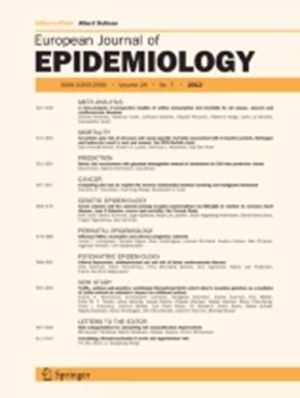欧洲自我报告结肠镜检查和粪便隐血检查使用率的最新趋势:2013-2015年和2018-2020年欧洲健康访谈调查分析
IF 5.9
1区 医学
Q1 PUBLIC, ENVIRONMENTAL & OCCUPATIONAL HEALTH
引用次数: 0
摘要
尽管在欧洲越来越多地实施结直肠癌(CRC)筛查项目,但多年来筛查试验的利用率却有很大的不同。我们研究了结肠镜检查和粪便潜血检查(FOBT)的使用趋势,这些检查是推荐用于CRC筛查的主要检查,在欧洲国家有各种筛查方案。分析来自第二和第三波欧洲健康访谈调查(EHIS)的基于人群的数据,以确定2013-2015年至2018-2020年期间50-74岁人群中前2年内粪便隐血检查或前10年内结肠镜检查使用率的变化。计算每个国家筛查试验使用的绝对百分比变化(APC),并使用随机效应模型进行亚组荟萃分析,以估计不同类别筛查方案的综合APC及其95%置信区间。共有来自28个欧洲国家的234251名受访者参与了分析。在2013-2015年至2018-2020年期间全面推行全国有组织的粪便检查筛查计划的国家,这两种检查的使用量增幅最高(增幅从比利时的19.1%到荷兰的46.3%不等),而在机会性提供粪便检查、结肠镜检查或灵活乙状肠镜检查的国家,这两种检查的使用量增幅最低(从德国的- 3%到斯洛伐克的+ 12.2%)。在所有筛查方案中,筛查方案的改变与结肠镜检查和粪便隐血检查的高使用率密切相关。我们的研究结果强调,组织良好和动态的人群筛查策略可以快速和可持续地提高欧洲CRC筛查试验的利用率。本文章由计算机程序翻译,如有差异,请以英文原文为准。
Recent trends in self-reported utilization of colonoscopy and fecal occult blood test in Europe: analysis of the European Health Interview Surveys 2013-2015 and 2018-2020.
Despite increasing implementation of colorectal cancer (CRC) screening programs in Europe, utilization of screening tests has varied significantly over the years. We examined recent trends in the utilization of colonoscopy and fecal occult blood test (FOBT), the primary tests recommended for CRC screening, across European countries with various screening programs. Population-based data from the second and third waves of the European Health Interview Survey (EHIS) were analyzed to determine changes in utilization of fecal occult blood test within the preceding 2 years or colonoscopy within the preceding 10 years among people aged 50-74 years between 2013-2015 and 2018-2020. Absolute percentage changes (APC) in screening test use were calculated in each country and subgroup meta-analyses were conducted using random effects models to estimate the pooled APCs and their 95% confidence intervals across different categories of screening offers. A total of 234,251 respondents across 28 European countries were included in the analysis. The increase in use of either test was highest among countries which fully rolled out nationwide organized screening programs with fecal tests between 2013-2015 and 2018-2020 (increases ranging from 19.1% units in Belgium to 46.3% units in The Netherlands) and was lowest among countries with opportunistic offering of fecal test, colonoscopy or flexible sigmoidoscopy (from - 3% units in Germany to + 12.2% units in Slovakia). Changes in screening programs were strongly associated with higher rates of utilization of colonoscopy and fecal occult blood test across all screening offers. Our findings highlight that well-organized and dynamic population screening strategies can rapidly and sustainably increase utilization of CRC screening tests in Europe.
求助全文
通过发布文献求助,成功后即可免费获取论文全文。
去求助
来源期刊

European Journal of Epidemiology
医学-公共卫生、环境卫生与职业卫生
CiteScore
21.40
自引率
1.50%
发文量
109
审稿时长
6-12 weeks
期刊介绍:
The European Journal of Epidemiology, established in 1985, is a peer-reviewed publication that provides a platform for discussions on epidemiology in its broadest sense. It covers various aspects of epidemiologic research and statistical methods. The journal facilitates communication between researchers, educators, and practitioners in epidemiology, including those in clinical and community medicine. Contributions from diverse fields such as public health, preventive medicine, clinical medicine, health economics, and computational biology and data science, in relation to health and disease, are encouraged. While accepting submissions from all over the world, the journal particularly emphasizes European topics relevant to epidemiology. The published articles consist of empirical research findings, developments in methodology, and opinion pieces.
 求助内容:
求助内容: 应助结果提醒方式:
应助结果提醒方式:


